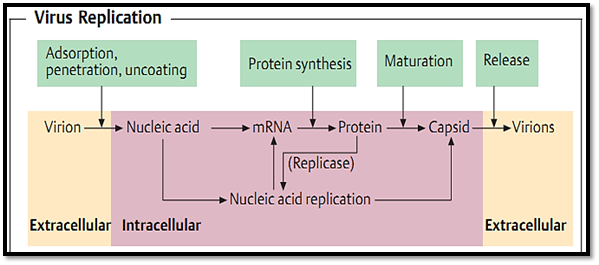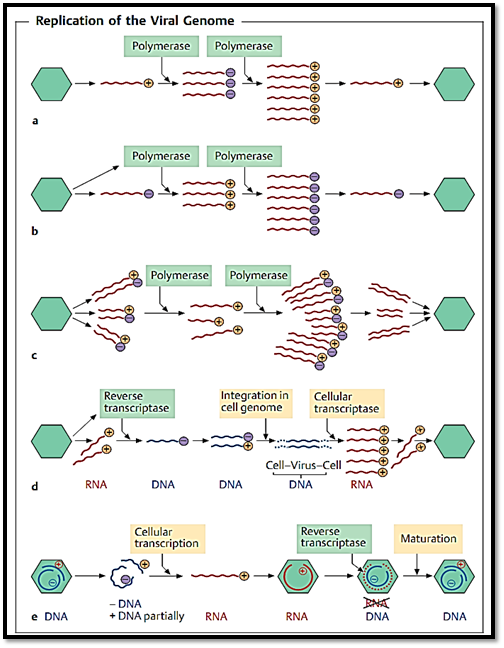
Replicationof virus
 المؤلف:
Kayser, F. H
المؤلف:
Kayser, F. H
 المصدر:
Medical Microbiology
المصدر:
Medical Microbiology
 الجزء والصفحة:
الجزء والصفحة:
 18-11-2015
18-11-2015
 2847
2847
Replicationof virus
The steps in viral replication are as follows:
-Adsorption of the virus to specific receptors on the cell surface.
-Penetration by the virus and intracellular release of nucleic acid.
-Proliferation of the viral components: virus-coded synthesis of capsid and noncapsid proteins, replication of nucleic acid by viral and cellular enzymes.
-Assembly of replicated nucleic acid and new capsid protein.
-Release of virus progeny from the cell.
viruses replicate only in living host cells. The detailed steps involved in their replication are shown below (Fig. 1). The reactions of the infected cell (cytopathology, tumor transformation, etc.).

Fig. 1. Replication of virus
Adsorption. Virus particles can only infect cells possessing surface “receptors” specific to the particular virus species. When a virus encounters such a cell, it adsorbs to it either with the capsid or, in enveloped viruses, by means of envelope proteins. It is therefore the receptors on a cell that determine whether it can be infected by a certain virus.
Receptors
Some aspects of the nature of the receptors are known. These are molecules that play important roles in the life of the cell or intercellular communication, e.g., molecules of the immunoglobulin superfamily (CD4: receptor for HIV; ICAM-1: receptor for rhinoviruses), the complement (C3) receptor that is also the receptor for the Epstein-Barr virus, or glycoproteins the cellular functions of which are not yet known.
Practical consequences arise from this growing knowledge about the receptors: on the one hand, it aids in the development of antiviral therapeutics designed to inhibit the adsorption of the viruses to their target cells. On the other hand, the genetic information that codes for certain receptors can be implanted into cells or experimental animals, rendering them susceptible to viruses to which they would normally be resistant. An example of this application is the use in experimental studies of transgenic mice rendered susceptible to polioviruses instead of primates (e.g., on vaccine testing).
Penetration and uncoating. Viruses adsorbed to the cell surface receptors then penetrate into the cell by means of pinocytosis (a process also known as viropexis). In enveloped viruses, the envelope may also fuse with the cell membrane, releasing the virus into the cytoplasm. Adsorption of such an enveloped virus to two cells at the same time may result in cell fusion. The next step, known as uncoating, involves the release of the nucleic acid from the capsid and is apparently (except in the smallpox virus) activated by cellular enzymes, possibly with a contribution from cell membranes as well. The exact mechanism, which would have to include preservation of the nucleic acid in toto, is not known for all viruses.
Replication of the nucleic acid. Different processes are observed corresponding to the types and configurations of the viral genome (Fig. 2).
-DNA viruses: the replication of viral DNA takes place in the cell nucleus (exception: poxviruses). Some viruses (e.g., herpesviruses) possess repli- cases of their own. The smaller DNA viruses (e.g., polyomaviruses), which do not carry information for their own DNA polymerase, code for polypeptides that modify the cellular polymerases in such a way that mainly viral DNA sequences are replicated.
Hepadnaviruses: the genome consists of an ssDNA antisense strand and a short sense strand (Fig. 2e). The infected cell transcribes an RNA sense strand (“template strand”) from the antisense strand. This template strand is integrated in virus capsids together with an RT DNA polymerase. The polymerase synthesizes a complementary antisense DNA and, to “seal off” the ends of the genome, a short sense DNA from the template strand.
-RNA viruses: since eukaryotic cells possess no enzymes for RNA replication, the virus must supply the RNA-dependent RNA polymerase(s) (“replicase”). These enzymes are thus in any case virus-coded proteins, and in some cases are actually components of the virus particle.
Single-stranded RNA: in sense-strand viruses, the RNA functions as mRNA “as is,” meaning the information can be read off, and the replicase synthesized immediately. Antisense-strand viruses must first transcribe their genome into a complementary strand that can then act as mRNA. In this case, the polymerase for the first transcription is contained in the mature virion and delivered into the cell. In ssRNA viruses, whether sense or antisense strands, complementary strands of the genome are produced first (Fig. 2a, b), then transcribed into daughter strands. They therefore once again show the same polarity as the viral genome and are used in assembly of the new viral progeny.
Double-stranded RNA: a translatable sense-strand RNA is produced from the genome, which consists of several dsRNA segments (segmented genome). This strand functions, at first, as mRNA and later as a matrix for synthesis of antisense-strand RNA (Fig. 2c). Here as well, an RNA-dependent RNA polymerase is part of the virus particle.
Retroviruses also possess a sense-oriented RNA genome, although its replication differs from that of other RNA viruses. The genome consists of two single-stranded RNA segments with sense polarity and is transcribed by an enzyme in the virion (reverse transcriptase [RT]) into complementary DNA. The DNA is complemented to make dsDNA and integrated in the cell genome. Transcription into sense-strand RNA is the basis for both viral mRNA and the genomic RNA in the viral progeny (Fig. 2d).

Fig. 2 Schematic diagram of nucleic acid replication. a Single-stranded RNA viruses with sense-strand genome: the virus-coded RNA polymerase transcribes the viral genome (+) into complementary strands (-) and these into new genomic RNA (+). The latter is then integrated in the viral progeny. b Single-stranded RNA viruses with antisense-strand genome: the RNApolymerase in the virion transcribes the viral genome (-) into complementary strands (+), which a virus-coded polymerase then transcribes into new genomic RNA (-).c Double-stranded RNA viruses: while still in the partially decapsidated virus particle, the virus-coded polymerase transcribes complementary strands (+) from the antisense strand of the (segmented) double-stranded viral genome; these complementary strands are complemented to make the new doublestranded viral genome. d RNA replication in retroviruses: the reverse transcriptase (RT) carried by the virion transcribes the viral genome (two sense-RNA strands) into complementary DNA (-), which is complemented to produce dsDNA and integrated in the cell genome. The viral RNA is first degraded. Cellular enzymes produce new genomic RNA (+). e DNA replication in hepadnaviruses: by means of cellular transcription, a sense-strand RNA is made from the viral genome (antisense DNA, partially double-stranded) and integrated in the new virion, where a virus-coded RT produces new genomic DNA (-) and destroys the RNA.
References
Fritz H. Kayser, M.D. Emeritus Professor of Medical Microbiology Institute of Medical Microbiology, University of Zurich, Zurich, SwitzerlandThieme 2005, Stuttgart ! New York.
 الاكثر قراءة في الفايروسات
الاكثر قراءة في الفايروسات
 اخر الاخبار
اخر الاخبار
اخبار العتبة العباسية المقدسة


